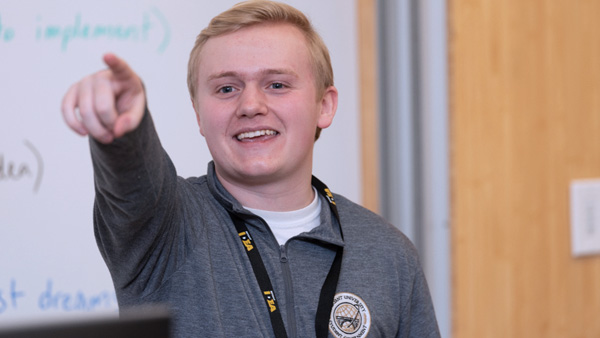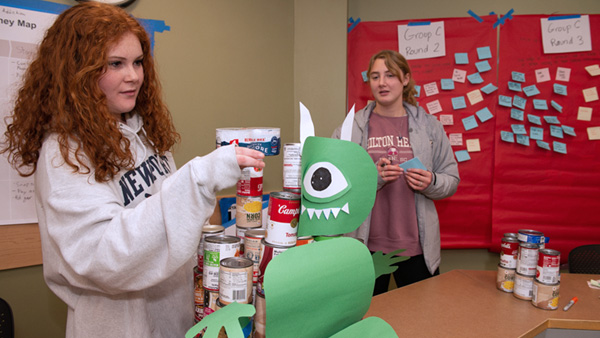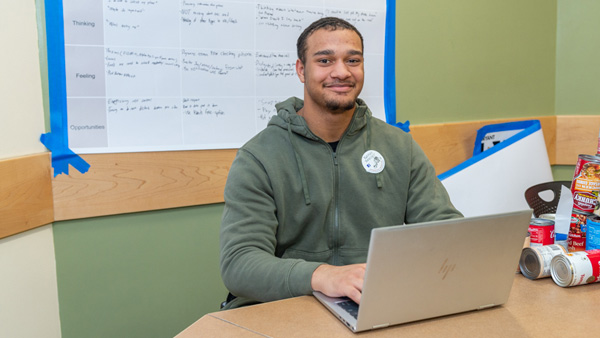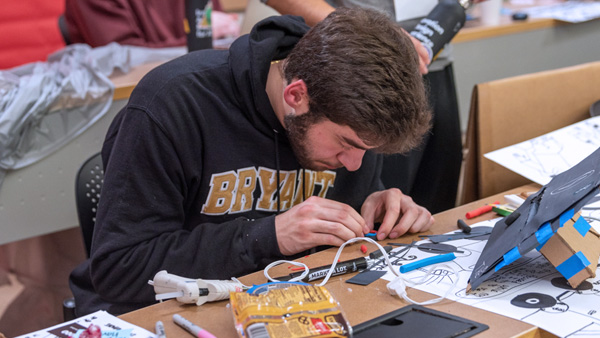“Move your butt if you’re excited about IDEA!”
Arranged in a circle where two hallways converge in Bryant University’s Unistructure, the group of students moves as fast as you’d expect on the first cold morning back from winter break — which is to say: They do not move at all.
Luke Lamontagne, ’24, who’s guiding this ice breaker exercise, lets out a “C’mon now!” that’s both enthusiastic and a little world-weary. The eighteen- and nineteen-year-olds laugh and crisscross the middle, jostling Lamontagne as they pass.
This brief moment of buy-in sets the tone for the students’ Innovation and Design Experience for All (IDEA) program, a three-day, one-credit course that immerses first-years in the design-thinking process. Nearly 1,000 participate in 2023’s program, now in its eleventh year, with forty cohorts tackling important societal problems with empathy and iteration.
They don’t know it yet but, over the course of the next three days, the young women and men assigned to Cohort 16 will develop deep-rooted, collaborative connections — and, for some, a sense of higher purpose — that will carry them through their next three-and-a-half years at Bryant.
“When you get the team dynamics right, you will experience the magic of joyful collaboration,” IDEA Director and Psychology Professor Allison Butler, Ph.D., predicted in her opening remarks in the MAC gymnasium, “and the exhilaration and the fun that comes with creating something innovative and important together.”

In their first mini design challenge of IDEA, the 24 students in Cohort 16 — arranged in teams of four or five — are charged with building wallets out of cardboard based on empathy interviews with peers.
Some students create earnest prototypes: Team E fashions a phone case wallet with one member’s ideal number of card slots. Team B creates a prototype with space for a tracking device. Team D, stocked with jovial, out-of-the-box thinkers, develops a wallet with Rubik’s Cube-style compartments that hangs from a belt loop, thus averting pocket bulk.
“You all just went through the entire design-thinking process in an hour and a half,” Lamontagne, their student mentor, tells the cohort before they break for lunch.
When the students return, they learn about their design challenge — the project that will dominate the remainder of their IDEA experience. Two marketing professionals from AAA Northeast, an IDEA sponsor, bring in a wrapped posterboard with the group’s challenge written in marker: “How might we curb screen addiction and help people achieve a healthy digital balance?” The idea was submitted by AAA Northeast — "a topic that really is within our wheelhouse to promote awareness," they tell the students. "The split second you're looking at your phone while driving can make a huge difference."

Later that afternoon, amid flurries of snow, the cohort boards a charter bus for field research at Providence Place mall, where they make note of a father and son sitting side-by-side, both on phones; a girl walking while staring at her phone; a dad on his phone while his child throws a tantrum; and other tales of public screen time.
After about 45 minutes, the students head back to campus. In the quiet dark of the bus, several fall asleep, waking upon return to grab dinner and head back to their cohort room for empathy interviews over Zoom. For an hour, the students ask personal and professional questions about screen time to community leaders, including Rahul Chand, vice president of marketing for AAA Northeast; Elissa Tracey, an MBA alumna and telecommunications consultant; and Sarah Falco '15, a software engineer who studied biology at Bryant.
Following the Zoom, the cohort releases some Day 1 steam with Canstruction, a creative building exercise where students assemble donated canned goods in the shape of an alien — “our Mike Wazowski,” says Cohort 16’s staff mentor Angelina Denomme, referencing the main character in Monsters Inc. Denomme, assistant director of online programs at Bryant, says she’s enjoyed watching the students transform over the course of Day 1.
“The first part of the day was hard; everyone was a bit reluctant in the beginning, but they’re willing to stay in the ring now,” she says. “It’s really amazing.”

Early in the morning of Day 2, the teams develop “how might we” questions and identify hundreds of potential solutions, which they write on Post-Its and stick to red sheets of paper on the wall.
“How might we reduce the need for people to check their phone?” the out-of-the-box thinkers in Group D ask. Their solutions: remove cell service from cars; get a lobotomy; conduct “Salem Phone Trials” for repeat offenders.
“These are good, these are great; there’s definitely some divergent thinking here,” says Cohort 16 faculty mentor Tingting Zhao, Ph.D., who leans into the mentor training directive to encourage all ideas, no matter how unusual. “Now, let’s shift from divergent thinking to convergent thinking.”
RELATED ARTICLE: On IDEA Day 2, students transform concepts, research into action
Zhao, an Assistant Professor of Information Systems and Analytics whose research involves medical applications of machine learning, is the students’ advocate in chief. She moves from team to team, asking questions and encouraging iteration as they prepare for storyboard pitches to visiting alumni mentors. Traditionally, each team presents two ideas and, following feedback from alumni, move forward on a singular prototype. But Team E — which pitches a coupon website promoting screen-free activities and a “Kid Phone” with strong parental controls — charts a new course, thanks to advice from alumni mentor Christopher DeVargas ’22.
“Is there a way for the coupons to be on the 'Kid Phone'?” asks DeVargas. “This way, you’re giving kids a choice and inspiring a lifetime of good habits.”
Nearing 8 p.m., the students begin building prototypes out of cardboard, tape, markers, and glue, which they’ll pitch to mystery judges in tomorrow’s exhibition. Conversations rarely stray from the work; they’re discussing screen time in depth, with nary a smartphone in sight.
“I’m pretty enthusiastic about this process,” says Andre Smith, an exercise science major, as he hot-glues his team’s prototype, a phone lockbox for the car. “When I begin my career, I’ll already be aware of the steps it takes to create an idea, test it out, and sell it.”
The students refine their prototypes, then head to the “Rest and Refresh” evening offerings, including a petting zoo and a student mentor flash mob starring their own IDEA Virgil, Lamontagne. Around 12 a.m., they’re released into the night. Tomorrow, they’ll pitch.

By 1 p.m. on Day 3 of IDEA, the first-year students in Cohort 16 have tweaked their prototypes; assigned individual pitch roles; written abbreviated 90-second pitches; honed their delivery; expanded their pitches to six minutes; and sat in nervous anticipation of the Innovation Exhibition, where anonymous judges assess their work, and that of other IDEA cohorts, in real time.
Forty-five minutes later, they walk over to the exhibition hall and set up their prototypes, waiting patiently for adults with clipboards to ask them tough questions.
Holly Dygert, a lecturer of English and Cultural Studies and a faculty mentor for a different cohort, floats over to Team C to learn about their prototype, an advocacy tool that pushes hotline alerts to users who have spent more than five hours scrolling.
“Can I please put this on my kids’ phones right now?” she asks the group.
RELATED ARTICLE: Generating game-changing results on Day 3 of IDEA
At the next table, members of Team D are also mulling the real-world implications of design thinking. Thus far, this group has provided levity to their cohort — think: Rubik’s Cube wallet; lobotomy as a solution to screen addiction — but two members share how they found meaning in this work; both lost high school classmates in car accidents where distracted driving was at play.
“This really is life or death,” says T.Y. McNeil while holding their prototype, a lockbox that uses artificial intelligence to rank-order notifications so only the most critical messages appear on a car’s display screen.
Kaden Hilburger describes how his classmate’s mother channeled the loss of her son into building a more robust drivers education program in their town.
“I know solutions matter," says Hilburger, "and what we’re trying to do here matters.”